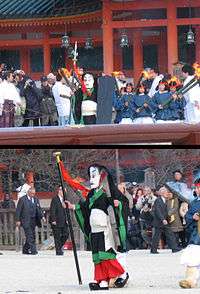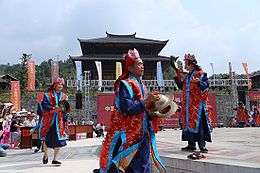Nuo folk religion
Nuo folk religion, or extendedly Chinese popular exorcistic religion, is a variant of Chinese folk religion with its own system of temples, rituals, orders of priests and gods, which is interethnic and practiced across central and southern China but is also intimately connected to the Yi and Tujia people.[1] It arose as an exorcistic religious movement, which is the original meaning of nuó (simplified Chinese: 傩; traditional Chinese: 儺). It has strong influences from Taoism.[2]
| Part of a series on |
| Chinese folk religion |
|---|
 |
|
Theory
Model humanity: |
|
Institutions and temples |
|
Internal traditions Major cultural forms
Main philosophical traditions: Ritual traditions: Devotional traditions: Zhenkong, "Void of Truth". Confucian churches and sects:
|
|
Related religions
|
One of the most distinguishing characters of Nuo folk religion is its iconographic style, which represents the gods as wooden masks or heads. This is related to its own mythology, which traces the origin of Nuo to the first two humans, who were unjustly killed by beheading and are since then worshipped as responsive divine ancestors.[3] Nuo rituals began as efficacious methods to worship them, Lord Nuo and Lady Nuo.[4] Since the 1980s Nuo folk religion has undergone a revitalisation in China, and today is a folk religion endorsed by the central government.[5] Nuo priests are classified as 巫 wu (shamans) and their historical precursors were the 方相氏 fangxiangshi ("masters who assist the (astral) square").
General theory
Cosmology
Nuo cosmology is based on a yin and yang theory, clearly represented in mythology, otherwise explainable as a world in which potentiality and actuality, supernature and nature, form a complementary and dialectical duality which is the order of the universe. Man is an active participant within this order, interplaying with the world of divinity in a creative manner. Nuo mythology also tells of a highest goddess,Tiānxiān (天仙 "Heavenly Immortal"), who is directly involved since the origin of humanity in triggering this dialogue between the spiritual and the material.[6] The primary form of dialogue is the worship of ancestors, and this is reflected in the patriarchal structure of Tujia society.[4]
Gods
Ancestral couple: Nuogong and Nuopo
The highest deities in the Nuo pantheon are Lord Nuo (傩公 Nuógōng) and Lady Nuo (Nuópó 傩婆), the two ancestors of humanity, according to mythology, whose sacrifice gave origin to Nuo practices.[4] When a Nuo ceremony is performed, the ancestral couple is represented by carved wooden statues erected in front of the temple, while all lesser gods are placed behind them. In simpler rituals, they are seen as embodiments of all the other gods.[4]
Three Purities and the Jade Deity
Generally, right below the ancestral couple of Nuogong and Nuopo come the Three Pure Ones (三清 Sānqīng). These are the main trinity of Taoist theology, and were introduced among the Tujia by Han Chinese who moved to their areas. Apart from the trinity and some elaborate ritual styles, Nuo folk religion has not acquired the philosophical contents of Taoism, as the purpose of Nuo practices is mainly to "nourish" Nuo gods.[7] Directly below the Three Pure Ones there is the Jade Deity (玉帝 Yùdì), another deity from Taoist theology, who is invoked by Nuo priests by blowing into a peculiar ritual instrument, an ox horn. The Jade Deity is conceived as the commander of all lesser gods, so in order to communicate with them it is necessary to call upon him first.[8]
Three Worlds' Deities, Five Directions' Deities and the Enthroned Deity
Below the Jade Deity come the Deities of the Three Worlds (三皇 Sānhuáng) and then the Deities of the Five Directions (五方帝 Wǔfāngdì), both groups common to pre-Taoist Chinese religion. The triplet is formed by the patron of heaven (天皇 Tiānhuáng, who is Fuxi), the patron of earth (地皇 Dehuáng, who is Nuwa) and the patron of humanity (人皇 Rénhuáng, who is Shennong).[9]
The other group is formed by the Yellow Deity of the centre of the cosmos, the Green or Blue Deity of the east, the Red Deity of the south, the White Deity of the east, and the Black Deity of the north. As in Chinese religion they have a cosmological significance corresponding to various aspects of nature and are believed to have been incarnated in historical personages.[9]
Below the Three Patrons and the Five Deities there is the Enthroned Deity, who is considered to be incarnated in the present time. The most prominent contemporary government figure of China is believed to be the Enthroned God. In Nuo shrines there is often a tablet with the inscription "a long life to the god on the throne".[10]
Founders of priestly orders
Every order of Nuo priests has its own founders, who are honoured at dedicated altars (师坛 shītán, "order's altar"). The ancestors of the order are invoked during every ritual performance and in the divine hierarchy they come right below the Enthroned Deity. The three earliest Nuo ritualists common to nearly all the orders are Yan Sanlang, Liu Wulang and Huang Wanlang.[11]
There are also a variety of gods of nature and of human affairs, such as the Door Gods, the Well God, the Hearth God, the Land God and the Wealth God, which are those with an immediate relationship with people despite their lower rank in the Nuo pantheon.[12]
Temples and ceremonies
The setting of Nuo activities are distinct temples (傩庙 nuómiào, "exorcism's temple") and private altars (傩坛 nuótán).[13] The main task of Nuo practices is to strengthen the power of gods as much as possible so that they can exorcise malevolent beings.[14]
Nuo ceremonies (傩仪 nuó yí) can involve dance performance (傩舞 nuó wǔ), songs (傩歌 nuó gē), sacrifices (傩祭 nuó jì) and the Nuo opera (傩戏 nuóxì).
Japanese Shinto rituals with Nuo origins

During the Heian period (794-1185), the Japanese adopted into Shinto many Tang dynasty (618-907) Chinese customs, including the fangxiangshi (the precursor of Nuo priests) known in Japanese as hōsōshi 方相氏 who would lead a funeral procession and exorcise demons from a burial mound. This practice was merged with traditional Japanese exorcistic rites such as the Shinto ofuda ("talisman with the name of a kami").
The earliest record was the (c. 797) Shoku Nihongi history,[15]:45 which mentions a hōsōshi exorcist officiating at the burial ceremonies for Emperor Shōmu (756), Emperor Kōnin (781), and Emperor Kanmu (806).
The Kyōgen actor Nomura Mannojō noted that Chinese nuo 儺 practices were the 8th-century source for the Japanese tsuina 追儺 or setsubun ("ritual to exorcise evil spirits on the last day of winter"), and proposed that supernatural power links the Chinese nuo performer fangxiangshi and the Japanese gigaku masked character Chidō 治道 ("govern the way") who leads a ceremony.[16]:258 In Japanese tradition and art, the hōsōshi wears a four-eyed mask rather than the original four-eyed bearskin.
See also
References
Citations
- Li (2003).
- Li (2016), p. 63.
- Li (2016), pp. 55-58.
- Li (2016), p. 58.
- Li (2010).
- Li (2016), pp. 57-58.
- Li (2016), pp. 63-64.
- Li (2016), pp. 64-65.
- Li (2016), p. 65.
- Li (2016), p. 66.
- Li (2016), pp. 66-67.
- Li (2016), p. 67.
- Li (2016), p. 62.
- Li (2016), p. 64.
- Gras, Alexandre (2004), "追儺における呪文の名称と方相氏の役割の変化について", Issues in Language and Culture 5: 35-53.
- Fukushima, Yoshiko (2005), "Masks, Interface of Past and Future: Nomura Mannojō's Shingigaku", Asian Theatre Journal 22.2: 249-268.
Sources
- Li, Lan (2016). Popular Religion in Modern China: The New Role of Nuo. Routledge. ISBN 1317077954.CS1 maint: ref=harv (link)
- Li, Lan (2010). "The Changing Role of the Popular Religion of Nuo (傩) in Modern Chinese Politics". Modern Asian Studies. 44 (2): 1–23. doi:10.1017/S0026749X10000090. ISSN 2157-9679.CS1 maint: ref=harv (link)
- Li, Lan (2012). Nuo (傩): The New Role of Popular Religion in Modern Chinese Politics. Hampshire: Ashgate Publishing.CS1 maint: ref=harv (link)
- Li, Lan (2003), The Reinvention of the Nuo Religion of the Tujia's Ethnic Identity and Identification, Belfast: Queens UniversityCS1 maint: ref=harv (link)
- Li, Lan (2008), Reinvention of the Belief - An Anthropological Study of the Chinese Popular Religion of Nuo, Kunming: Yunnan People's PublisherCS1 maint: ref=harv (link)
- Li, Lan (2009), "Who Controls the Fate of an ICH – A Case Study of Nuo (儺) in Southwest China", in Lira, Sérgio; Amoê, Rogério; Prinheiro, Cristina; Oliveira, Fernando (eds.), Sharing Culture, Green Lines Institute for Sustainable DevelopmentCS1 maint: ref=harv (link)
